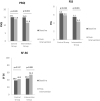An anti-inflammatory and low fermentable oligo, di, and monosaccharides and polyols diet improved patient reported outcomes in fibromyalgia: A randomized controlled trial
- PMID: 36091254
- PMCID: PMC9450131
- DOI: 10.3389/fnut.2022.856216
An anti-inflammatory and low fermentable oligo, di, and monosaccharides and polyols diet improved patient reported outcomes in fibromyalgia: A randomized controlled trial
Abstract
Background: Fibromyalgia (FM) has been associated with dysbiosis and low-grade inflammation. Studies have reported that diet influences clinical features in FM.
Objective: To evaluate the effect of an anti-inflammatory and low fermentable oligo, di, and monosaccharides and polyols (FODMAP) diet on clinical outcomes of patients with FM.
Methods: This two arms Randomized Controlled Trial (NCT04007705) included 46 female patients with FM. The intervention group (n = 22) adopted an anti-inflammatory diet for 3 months, excluding gluten, dairy, added sugar, and ultra-processed foods, along with a low FODMAPs diet in the first month. The control group (n = 24) followed general healthy eating recommendations. Both diets were applied by a certified dietitian. Before and after the intervention, participants were assessed regarding pain, fatigue, gastrointestinal symptoms, quality of sleep, and quality of life, through the Revised Fibromyalgia Impact Questionnaire (FIQR), Visual Analogue Pain Scale (VAS), Visual Analog Scale from gastrointestinal symptoms (VAS GI), Brief Pain Inventory (BPI), Pittsburg Sleep Quality Index (PSQI), Fatigue Severity Survey (FSS), and The Short Form Health Survey (SF-36). A blood sample was collected and high-sensitive C-Reactive Protein and Erythrocyte Sedimentation Rate were quantified. Paired Samples t-test/Wilcoxon and independent samples t-test/Mann-Whitney were used to compare variables between groups.
Results: After intervention, there was an improvement in intervention group scores of FIQR (p = 0.001), VAS (p = 0.002), BPI (p = 0.011), FSS (p = 0.042), VAS_GI (p = 0.002), PSQI (p = 0.048), and SF36 (p = 0.045) compared to control group. Inflammatory biomarkers (hs-CRP, ESR) did not change in both groups. The intervention was beneficial in the intervention group, regardless of age, disease duration, body mass index variation, and body fat change between baseline and post-intervention.
Conclusion: An anti-inflammatory and low-FODMAP diet improved clinical features in patients with FM and may be useful as a complement to pharmacological therapy.
Clinical trial registration: [https://clinicaltrials.gov/ct2/show/NCT04007705], identifier [NCT04007705].
Keywords: SIBO; anti-inflammatory diet; dysbiosis; fibromyalgia; inflammation; low FODMAPS diet; randomized controlled trial; small intestinal bacterial overgrowth.
Copyright © 2022 Silva, Bernardo, de Mesquita, Vaz-Patto, Moreira, Silva and Padrão.
Conflict of interest statement
The authors declare that the research was conducted in the absence of any commercial or financial relationships that could be construed as a potential conflict of interest.
Figures


Similar articles
-
A study protocol for a randomized controlled trial of an anti-inflammatory nutritional intervention in patients with fibromyalgia.Trials. 2021 Mar 9;22(1):198. doi: 10.1186/s13063-021-05146-3. Trials. 2021. PMID: 33743794 Free PMC article.
-
A low fermentable oligo-di-mono saccharides and polyols (FODMAP) diet reduced pain and improved daily life in fibromyalgia patients.Scand J Pain. 2016 Oct;13:166-172. doi: 10.1016/j.sjpain.2016.07.004. Epub 2016 Aug 22. Scand J Pain. 2016. PMID: 28850525
-
A low fermentable oligo-di-mono-saccharides and polyols (FODMAP) diet is a balanced therapy for fibromyalgia with nutritional and symptomatic benefits.Nutr Hosp. 2017 Jun 5;34(3):667-674. doi: 10.20960/nh.703. Nutr Hosp. 2017. PMID: 28627205
-
Dietary interventions in fibromyalgia: a systematic review.Ann Med. 2019;51(sup1):2-14. doi: 10.1080/07853890.2018.1564360. Ann Med. 2019. PMID: 30735059 Free PMC article.
-
A Systematic Review and Meta-Analysis Evaluating the Efficacy of a Gluten-Free Diet and a Low FODMAPs Diet in Treating Symptoms of Irritable Bowel Syndrome.Am J Gastroenterol. 2018 Sep;113(9):1290-1300. doi: 10.1038/s41395-018-0195-4. Epub 2018 Jul 26. Am J Gastroenterol. 2018. PMID: 30046155
Cited by
-
Restrictive Diets in Patients with Fibromyalgia: State of the Art.Biomedicines. 2024 Mar 12;12(3):629. doi: 10.3390/biomedicines12030629. Biomedicines. 2024. PMID: 38540241 Free PMC article. Review.
-
Nutrition and Chronobiology as Key Components of Multidisciplinary Therapeutic Interventions for Fibromyalgia and Associated Chronic Fatigue Syndrome: A Narrative and Critical Review.Nutrients. 2024 Jan 5;16(2):182. doi: 10.3390/nu16020182. Nutrients. 2024. PMID: 38257075 Free PMC article. Review.
-
T Lymphocyte Interferon-gamma Response to Anaplasmataceae-related Major Surface Proteins and Ankyrin A in Fibromyalgia.CNS Neurol Disord Drug Targets. 2024;23(11):1392-1399. doi: 10.2174/0118715273274091231207101522. CNS Neurol Disord Drug Targets. 2024. PMID: 38375844
-
Effect of anti-inflammatory diets on health-related quality of life in adults with chronic disease: a systematic review and meta-analysis.BMJ Nutr Prev Health. 2025 Jun 10;8(1):e001257. doi: 10.1136/bmjnph-2025-001257. eCollection 2025. BMJ Nutr Prev Health. 2025. PMID: 40771529 Free PMC article.
-
Effectiveness of the SYNCHRONIZE + Brief Intervention in Improving Mediterranean Diet Adherence, Nutritional Quality and Intake Pattern in Persons with Fibromyalgia and Chronic Fatigue Syndrome.Nutrients. 2024 Dec 24;17(1):11. doi: 10.3390/nu17010011. Nutrients. 2024. PMID: 39796445 Free PMC article. Clinical Trial.
References
Associated data
LinkOut - more resources
Full Text Sources
Medical
Research Materials
Miscellaneous

